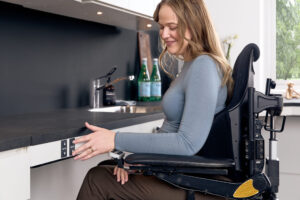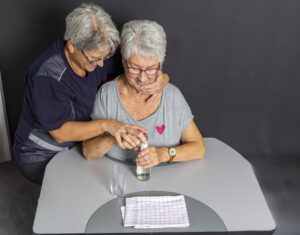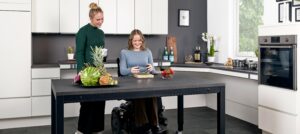The benefits of using a training kitchen
Jul 9, 2019
•Kitchen solutions
Table of Contents
Rehabilitation training kitchens with adjustable worktops and accessible design help patients regain independence, confidence, and essential daily kitchen skills.

Rehabilitation is a vital part of the recovery programme for anyone who has suffered a stroke, brain or spinal injury.
Depending on the level of injury and mobility, some people can regain their independence relatively quickly, while for others, it can be a case of learning how to do things from scratch and no where is this more challenging than in the kitchen.
Ropox, one of the UK’s leading suppliers of accessible bathrooms and kitchens is helping to address this with its range of adjustable kitchen work tops and cupboards which have been designed to make the kitchen as accessible as possible to people with reduced mobility.
Many care settings and rehabilitation centres are now using this type of equipment in training kitchens to help their patients regain some independence and increase their confidence. A training kitchen may be used for teaching specific skills, testing and assessing of abilities and monitoring how a patient is progressing.
There are a huge number of acitivies performed in a kitchen, all of which need to be taken into consideration. These include:
• Moving between work stations
• Worktop food preparation
• Cleaning vegetables etc at the sink
• Washing up
• Cooking at the hob
• Using the oven
• Accessing the fridge and freezer
• Cleaning
Listing and prioritising the importance of each of the above and possibly even more activities can help when developing the design brief to ensure the final design and layout meets the needs of everyone involved.
Individual users will often need to carry out these activities at different heights. For example, cooking at the hob may be easier at lower heights than when washing up at the sink and using a mixing bowl at a lower worktop height than when slicing vegetables.
The whole point of the therapy kitchen is that it will provide people with the best chance of rehabilitation. They can learn or re-learn individual skills at the three main working areas – the hob, preparation area and sink while also having access to the oven and fridge.
The electric height adjustment makes it possible for people to work at the most ergonomic height and with good leg access below, seated patients can get the best possible position in relation to the work surface while people who stand can work at the best height for their balance or reach.
The linear design of a worktop split in two, allows two people to work in the same area and therapists/trainers can help from the left or the right-hand sides of each individual with the end result being a faster recovery of important skills.
One such example of a care setting which is using a therapy kitchen can be found at Homerton Transitional Neurological Rehabilitation Unit in east London. Two years ago, the unit installed a therapy kitchen consisting of an oven with a fold away door, hob, sink, two adjacent Ropox electric height adjustable worktops and an adjustable wall unit system. The worktops have a 300mm height adjustment which provides a worktop height range of 690mm to 990mm making it suitable for most wheelchair users and both staff and residents are reaping the rewards as Joanna Lyndon-Cohen, a Highly Specialist Occupational Therapist, at the unit explains.
“We have patients here with a range of neurological conditions ranging from strokes and traumatic brain injuries to spinal cord issues, Parkinson’s and MS; and over the past two years many patients have benefitted from the equipment.
“When people have suffered a stroke, brain or spinal cord injury, they will have often gone from being more independent to needing help to do daily activities. It is our role here to help manage this and often re-educate them so they can once again complete day-to-day tasks which we all take for granted.
“For many of our patients, being able to make their own meals is hugely important as it can help with their independence and confidence and the training kitchen provides them with the opportunity to practice their meal preparation skills.
“By having a split-level work top, one patient can be working from their wheelchair while another can be working from a standing position. .”
Among the patients currently using the training kitchen is Mustafa who has benefited greatly from being able to use all the equipment. He says: “The kitchen is very easy to use and has really helped with my confidence. I can now make a cup of tea, my own breakfast and prepare my home-made soup”.
Joanna explains: “When Mustafa arrived he was using a wheelchair. He has now progressed to just using a walking frame, and thanks to the height adjustable worktops he has been able to use the kitchen from day one. From our perspective, seeing the difference a training kitchen can make is just fantastic.”
What do you need to install a training kitchen?
Products that are adjustable to fit the individual user’s needs. Accessibility to make it possible for everyone to use the kitchen and user-friendliness to make it easy to adjust and operates.
Read more in The Building Regulations 2010. Find the wheelchair accessible lay-out on page 37.


